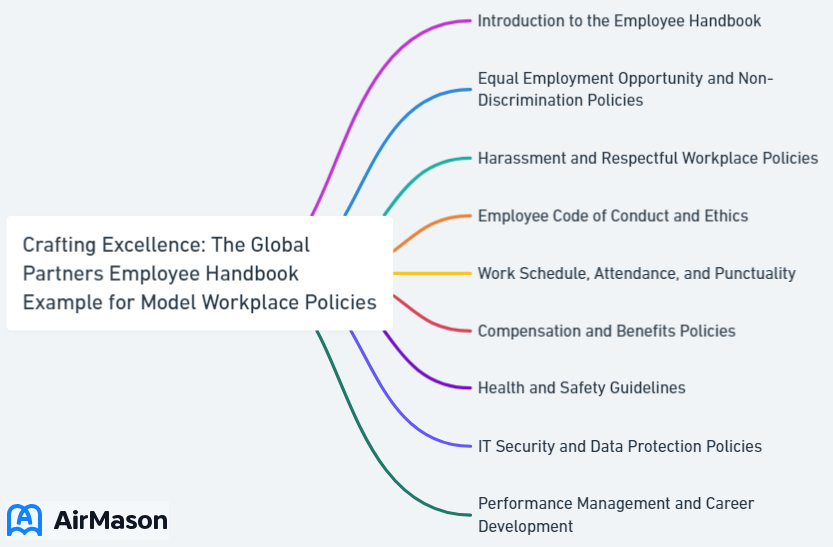
Are you seeking inspiration to craft or update an employee handbook that meets global standards? Look no further. Our article provides a detailed look at a Global Partners employee handbook example, showcasing essential elements that help build a coherent and comprehensive guide for your team. Discover key policies, cultural insights, and compliance tips that contribute to a robust workplace framework and learn from a model that aligns company values with everyday practices.
Key Takeaways
- The Global Partners Employee Handbook is a comprehensive resource that reflects the company’s mission and core values, such as integrity and inclusivity, and provides clear guidance on workplace policies to ensure a constructive work environment.
- The employee handbook includes detailed sections on remote work policies and maintaining company culture virtually, offering strategies such as employing specific communication tools and promoting team-building activities to foster employee connections.
- A strong emphasis on employee benefits, health and wellness programs, and professional development opportunities is crucial to attracting and retaining talent, boosting morale, and enhancing job satisfaction.
Global Partners Employee Handbook: A Model Example
The Global Partners Employee Handbook stands as a comprehensive guide, reflecting the company’s core values. It illustrates how a well-crafted handbook can lay a solid foundation for employee success and cultivate a conducive work environment.
The handbook articulates the company’s mission, thus fostering diversity and inclusivity. It encapsulates the company’s values to dress codes, thereby creating a constructive work environment. This illustration signals the power of an employee handbook in molding employee behavior and morale.
Fortune 500 Companies Employee Handbook
In the intricate landscape of corporate guidelines and policies, the Fortune 500 Companies Employee Handbook stands as a cornerstone document. This comprehensive guide serves as an invaluable resource for employees, outlining the principles and expectations that shape the work environment within these influential organizations. The Fortune 500 Companies Employee Handbook not only provides a roadmap for professional conduct but also encapsulates the values and standards that define these industry-leading entities. By familiarizing themselves with the content of this handbook, employees gain insights into the corporate culture and ethos that contribute to the success of Fortune 500 companies. As a vital tool for both employers and employees alike, the Fortune 500 Companies Employee Handbook sets the stage for a collaborative and thriving workplace.
Company Culture and Core Values
A company’s culture and core values are the heart and soul of its employee handbook. They set the tone for how the company operates and what it stands for. A prime example is the Paramount Global Employee Handbook, which prioritizes fundamental principles like:
- Integrity
- Innovation
- Optimism
- Determination
- Inclusivity
These company values are not just words on a page. They are the guiding principles that shape how employees interact, solve problems, and contribute to the company’s success.
Another noteworthy example is Hubspot, which uses a conversational and playful tone in its employee manual. This strategy makes their policies engaging, insightful, and relatable, proving that an employee handbook can be both informative and enjoyable to read. These examples show that establishing a strong foundation for employee engagement, collaboration, and success starts with aligning your company culture and core values with your handbook.

Comprehensive Workplace Policies
Workplace policies make up a crucial component of an employee handbook, offering clear guidelines on aspects like safety, anti-discrimination, and performance management. Incorporating a company’s code of conduct in the handbook, for instance, discourages employees from participating in negative behavior and promotes the adoption of positive behaviors and attitudes. It also establishes ethical standards and legal compliance for everyone associated with the company.
The Paramount Employee Handbook provides:
- Clear communication channels
- Development opportunities
- Effective performance management processes
- Necessary policies like dress code, PTO policy, parking guidelines, and reimbursement processes
These comprehensive workplace policies ensure that employees have clear guidance and know what to expect in various situations.
Adapting to Remote Work and Virtual Collaboration

With the ongoing digital revolution, companies are adopting flexible and remote work arrangements, which necessitates updating the employee handbook accordingly. A comprehensive employee handbook should include:
- A clear vision for remote work
- A comprehensive remote work policy
- Guidelines on time management
- Guidance on maintaining the company culture while working remotely
Transitioning to remote work shouldn’t compromise company culture but rather serve as a chance to strengthen employee connections and uphold organizational values. Therefore, the employee handbook should also contain strategies for upholding the company culture in a virtual work environment. This involves:
- Fostering trust
- Emphasizing employee wellbeing
- Setting an example through senior leadership
- Promoting transparent communication
Remote Work Guidelines
An effective remote work policy is a must in today’s increasingly digital workplace. It should include the following:
- Clear expectations for remote employees
- Suitable roles for remote work
- Availability during agreed schedules
- Communication guidelines
- Productivity expectations
- Work-life balance considerations
- Security measures for remote equipment to protect company data
Having a comprehensive remote work policy in place will help ensure a smooth transition to remote work and set the foundation for a successful remote work environment.
Creating a remote work policy involves several key elements to ensure a balanced and fulfilling work experience for remote employees. These include:
- Setting clear expectations
- Establishing routines
- Providing necessary technology and tools
- Encouraging a solid work-life balance
By implementing these strategies, companies can create a successful remote work environment.
Moreover, managing remote teams effectively entails implementing virtual team-building opportunities, clear communication channels, and regular feedback and support.
Maintaining Company Culture Virtually
Upholding the company culture in a remote setting can be challenging, yet with proper strategies, it’s an achievable goal. Utilizing tools like:
- Video conferencing
- Virtual meetings
- Shared documents
- Project management tools
can facilitate remote collaboration and maintain a sense of connection among employees.
Moreover, virtual team-building activities can enhance the company culture by elevating employee performance, fostering morale and engagement, and strengthening social relations. Activities like posing icebreaker questions or organizing virtual lunch dates can promote a sense of belonging and camaraderie among remote employees, ultimately fostering a healthy and positive work environment.
Employee Benefits and Perks

Employee benefits and perks are instrumental in luring and retaining premier talent. They contribute significantly to improving job satisfaction and retention. Enhanced benefits like health insurance and retirement plans can boost employee morale. Competitive compensation packages can attract skilled employees, and investment in employee growth and development enhances engagement and loyalty.
Paramount offers a wide range of benefits, including:
- Paid holidays and vacation
- 401(k) contributions
- Option to work from home
- Paid sick leave
- Life insurance/disability coverage
- Casual dress/atmosphere
- Education/training/tuition reimbursement
These benefits demonstrate how a well-rounded benefits package can effectively boost employee satisfaction and morale.
Health and Wellness Programs
Health and wellness initiatives foster a healthier work environment. They aid in stress management, enhance resilience, and improve overall wellbeing, resulting in elevated job satisfaction and retention. Moreover, they can contribute to reduced healthcare costs, decreased sick leave, and enhanced productivity.
Examples of health and wellness programs include:
- Flexible working hours
- Remote working arrangements
- Financial education
- On-site fitness centers
- ‘Quit Smoking’ programs
- Provision of healthy snacks
- Promotion of fitness at work
- Employee discounts for gym memberships
- Mindfulness and meditation programs
Incorporating these into your employee handbook shows your commitment to inform employees about their health and wellbeing.
Mosaic Employee Handbook Example
In this Mosaic Employee Handbook example, we meticulously outline the principles and guidelines that define our organizational culture. The Mosaic Employee Handbook exemplifies our commitment to fostering a positive work environment and providing clear expectations for our valued team members. This comprehensive document serves as a reference for employees, offering insights into company policies, professional conduct, and the shared values that form the foundation of our workplace. Through the Mosaic Employee Handbook example, we aim to empower our staff with the knowledge and resources needed to thrive within our dynamic and collaborative organization.
Professional Development Opportunities
Supplying resources and support for continuous learning and growth is pivotal for enhancing employee satisfaction and performance. Professional development opportunities demonstrate a commitment to employee success, which can enhance morale and performance. They also contribute to improved performance by increasing employees’ confidence and maintaining their motivation.
Professional development opportunities can range from:
- professional organizations
- networking events
- industry conferences
- coaching
- performance reviews
- online courses and certificates
- formal education programs
- training programs
- seminars
- webinars
- workshops
Investing in the professional development of employees yields advantages such as attracting and retaining top talent, fostering a culture of ongoing learning, enhancing job satisfaction, and driving increased profits by reducing turnover.
Legal Aspects and Compliance

The inclusion of legal aspects in an employee handbook is vital to:
- Educate employees about their rights
- Ensure the company’s compliance with pertinent laws
- Safeguard the company’s intellectual property
- Effectively manage employment relationships
While there are no specific federal or state regulations that dictate the necessity of an employee handbook for employers in the United States, having one is considered a best practice.
Some countries, such as Japan, France, and Belgium, have specific employment laws that require companies to provide an official employee handbook outlining mandatory work rules. In addition to these employee handbooks, it’s important to note that neglecting to regularly update the employee handbook can expose the company to litigation risks if the manual fails to incorporate essential changes each year. Therefore, it’s advisable to conduct an annual review to uphold accuracy and compliance.
Employment Laws and Regulations
Complying with applicable laws and informing employees of their rights and responsibilities is of utmost importance. Essential federal employment laws that companies should be mindful of in the United States encompass:
- Fair Labor Standards Act (FLSA)
- Title VII of the Civil Rights Act of 1964
- Americans with Disabilities Act (ADA)
- Age Discrimination in Employment Act (ADEA)
- Family and Medical Leave Act (FMLA)
Paramount ensures adherence to legal obligations through the following measures:
- Conducting investigations to uphold anti-retaliation provisions
- Implementing policies to safeguard employee privacy
- Potential disclosure of personal information to unions or similar worker-representing organizations
Paramount processes personal information only in accordance with the law, keeping employee privacy and data protection at the forefront.
Intellectual Property and Confidentiality
Protecting company assets and maintaining confidentiality is crucial in today’s digital age. Intellectual property, including patents, trademarks, copyrights, and trade secrets, needs to be safeguarded. Companies can do this by providing employee training, employing data encryption, managing access to sensitive information, conducting asset inventory, defining user roles, establishing a clear IP policy, and drafting confidentiality and non-disclosure agreements.
Paramount enforces comprehensive policies designed to:
- Prevent unauthorized access and breaches
- Uphold the privacy and security of company data
- Ensure the protection of valuable assets
- Foster innovation within the organization
Best Practices for Creating Your Own Employee Handbook

Creating a custom company’s employee handbook necessitates a profound understanding of the company’s unique characteristics, encompassing its personality, norms, and legal requirements. A handbook should reflect the company’s:
- Foundation
- Mission
- Core values
- Compliance with employment law
It should align with the company’s culture and values, setting the tone for how employees interact, solve problems, and contribute to the company’s success.
Examining other employee handbook examples can assist in ensuring comprehensive coverage and may provide inspiration for tailoring or improving handbook content to align with the unique requirements of your company. This allows you to create new employees employee handbooks that truly reflect your company’s ethos and guides your employees effectively.
Customizing Policies and Procedures
It’s imperative to tailor your handbook to align with your company’s specific needs, industry, and culture. This involves:
- Conducting periodic reviews to ensure current and legal policies
- Incorporating vital details about organizational policies, procedures, and expectations
- Using clear and concise language
- Consistently updating the handbook to maintain alignment with company practices and ensure adherence to policies and procedures.
However, care must be taken to avoid common errors such as:
- using inconsistent or ambiguous language
- creating overly restrictive policies
- failing to outline consequences for policy violations
- discouraging employee feedback
- adopting a one-size-fits-all approach without considering specific organizational needs
Integrating diversity and inclusion into the handbook is also essential to create a diverse and inclusive workplace.
Western Digital Employee Handbook Example
In the context of organizational guidelines and protocols, the Western Digital Employee Handbook Example serves as a comprehensive resource for employees, outlining the company’s policies and expectations. This handbook encapsulates the values and principles that define Western Digital’s work culture, providing a roadmap for professional conduct and fostering a positive work environment. Employees can refer to this document to gain insights into the company’s ethos, guidelines for interpersonal interactions, and standards for professional behavior. The Western Digital Employee Handbook Example is not just a set of rules but a tool that empowers employees to thrive in their roles while aligning with the company’s overarching mission and vision.
Keeping the Handbook Up-to-Date
Regular updating of your employee handbook is of equal importance. This includes utilizing clear and understandable language, avoiding legal jargon, including only pertinent information, and regularly updating the handbook to accommodate changes in policies or regulations. It’s recommended to update an Employee Handbook on an annual basis, at a minimum. Updates may be triggered by changes to federal, state, or local employment laws, disciplinary actions, collective bargaining agreements, updates to policies such as social media and data privacy, reasonable accommodations, retaliation prevention policies, new hires, internal feedback, and legal requirements for distributing written policies.
Neglecting to regularly update the employee handbook can expose the company to litigation risks if the manual fails to incorporate essential changes each year. This can lead to employee confusion and legal vulnerability, potentially resulting in penalties, fines, and lawsuits. Therefore, it’s advisable to conduct an annual review to uphold accuracy and compliance.
Summary
Creating an effective employee handbook is an art that requires meticulous crafting. The handbook is a testament to your company’s culture, policies, and expectations. It plays a pivotal role in fostering a positive work environment and in laying the groundwork for employee success. From establishing your company’s culture and values to outlining comprehensive workplace policies, adapting to remote work, highlighting employee benefits and perks, ensuring legal compliance, and providing professional development opportunities, the handbook is an essential tool for every organization.
In today’s dynamic work environment, the importance of a comprehensive, up-to-date employee handbook cannot be overstated. Whether you’re a startup or a Fortune 500 company, investing time and resources in creating and maintaining an effective employee handbook can yield significant benefits. It can boost employee morale, foster a positive work environment, attract and retain top talent, and protect your company from potential litigation. So go ahead, craft an employee handbook that truly reflects your company’s ethos and guides your employees effectively.
Frequently Asked Questions
How can I make my employee handbook more interesting?
To make your employee handbook more interesting, consider incorporating images, illustrations, and other visuals to break up the text and make it more visually appealing and easy to understand. This can help engage your employees and make the handbook more appealing.
How do I create an employee handbook template?
To create an employee handbook template, follow these steps: Understand your company’s history, identify required policies, include other necessary policies, avoid unnecessary policies, reflect company values in drafted policies, set the tone, and gather feedback from employees.DATE
Why is it important to have an effective employee handbook?
Having an effective employee handbook is important because it accurately represents the company and fosters a positive work environment by outlining company culture, policies, and expectations. It guides employees through their journey within the organization.
How can an employee handbook be adapted for remote work?
To adapt an employee handbook for remote work, include clear policies and guidelines for remote work, time management, and maintaining company culture while working remotely. This ensures that employees have the necessary tools and expectations for successful remote work.
What are some of the benefits and perks that employees value most?
Employees value flexible work hours, retirement plans, paid time off, health, dental, and vision insurance, flexible schedules, remote work options, and early Fridays. These benefits are highly prioritized by employees.
Important Disclaimer:
The article presented here does not serve as a representation of the company’s actual employee handbook mentioned in this article.
Our discussions and insights regarding employee handbook are based on assumptions about what may be considered significant in the companies’ policies. These assumptions are drawn from available information and industry knowledge. Readers are advised that the content provided is for informational purposes only and should not be construed as an exact reflection of any company’s official policies or procedures. For precise and accurate details regarding a company’s employee handbook, individuals should refer directly to the company’s official documentation or consult with appropriate representatives.
Please be aware that the content on this page has been generated by using artificial intelligence language models and may contain errors, inconsistencies, or outdated information. It is provided as-is without any warranties or guarantees of accuracy. We strongly recommend using this content as a starting point for further research. We disclaim any liability for damages or losses resulting from the use or reliance on this content.